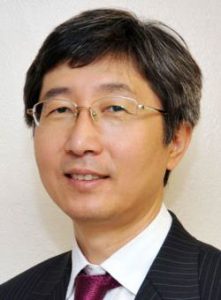 The PRiME Lecture will take place as an online event on Monday, October 5, 2020, starting at 2000h EDT / Tuesday, October 6, 2020, at 0900h JST & KST. Visit here to register for this event.
The PRiME Lecture will take place as an online event on Monday, October 5, 2020, starting at 2000h EDT / Tuesday, October 6, 2020, at 0900h JST & KST. Visit here to register for this event.
Dr. Nam-Gyu Park, Professor and SKKU-Fellow at the School of Chemical Engineering at Sungkyunkwan University, will lead the PRiME 2020 plenary this year as the featured lecturer, presenting his talk, “Perovskite Solar Cells: Past 10 Years and Next 10 Years.”
What’s it all about? Dr. Park, a solid-state perovskite solar cell pioneer, chatted with ECS and shared the message behind his talk, including his work with perovskite solar cells, the materials significance to the science community as a whole, and the future of the promising material.
Q&A with Dr. Nam-Gyu Park
Q: What will your talk, “Perovskite Solar Cells: Past 10 Years and Next 10 Years,” cover?
A: My talk will cover the history of perovskite solar cells, the progress of perovskite solar cells, state-of-the technology in perovskite solar cells, and research direction of perovskite solar cells for the next 10 years.
Inorganic-organic lead halide perovskite was first applied to dye-sensitized solar cell structure in 2009 by the Miyasaka group, where organic dye molecule was replaced by nanocrystalline methylammonium lead iodide perovskite. Power conversion efficiency was about 3.8% (this means electrical power of 3.8 mW/cm2 is generated by absorbing sunlight power of 100 mW/cm2). A doubled efficiency of 6.5% was reported in 2011 by Park group (our group) using methylammonium lead iodide perovskite deposited on thin TiO2 film. However, a quick dissolution of perovskite in liquid electrolyte in the dye-sensitized solar cell structure is problematic for further development. In 2012, we developed first the stable and 9.7% efficiency solid-state perovskite solar cell, which was reported in Scientific Reports (Nature Publishing Journal).
After this groundbreaking discovery, there has been a swift surge in perovskite photovoltaics researches. Since 2012, there is great progress in perovskite solar cell research, as a result, power conversion efficiency of 25.2% was achieved in 2019. Fabrication processing and compositional engineering contributed to a significant increase in efficiency, where the Lewis acid-base adduct approach to get high-quality perovskite film will be explained. Ion migration is a unique property in organic lead halide perovskite, which however generates a current-voltage hysteresis and has a negative effect on stability. Methodology to eliminate the hysteresis will be introduced along with an explanation of the mechanism for the suppression of ion migration. Interface engineering will be also discussed in order to reduce recombination and thereby increase photovoltaic performance, where post-treatment and additive engineering will be introduced as a method for interface engineering.
For the next 10 years, there are two important research directions: One is a scientific and technological strategy to achieve a theoretical efficiency over 30% and the other is related to the commercialization of perovskite solar cells. For achieving the theoretical efficiency, voltage and fill factor should be increased, which can be possible by defect and recombination control. For commercialization, large-area fabrication is inevitably required. Precursor solution chemistry and large-area coating method will be introduced to achieve a homogeneous and high-quality perovskite film on large-area substrate. Finally, perspective of perovskite solar cells will be described.
Q: Why are perovskite solar cells an important topic to highlight to the science community?
A: Perovskite solar cells are a very interesting topic because it is different from the conventional semiconductor-based solar cells. Perovskite is a mixed conductor. Perovskite show high dielectric constant that is even significantly increased upon illumination. Electrochemical impedance has been used frequently to study perovskite and its interface. Perovskite is dynamic because organic cation is vibrating even at room temperature, which changes dipoles and dipole moments. Power conversion efficiency of perovskite solar cells is close to the best efficiency of Si solar cells. A large spin-orbit coupling in perovskite creates a long carrier lifetime in such a direct bandgap transition material.
Q: PRiME 2020 draws in attendees with a wide range of specialties and focuses, including batteries, sensors, corrosion, photonics, and more. How is this talk of interest to anyone attending?
A: As I previously mentioned, organic lead halide perovskite is a very interesting and promising material because of its unique opto-electronic property. This star material is not only used for photovoltaics but also X-ray imaging system, light-emitting diode, laser, hydrogen production, and even Lithium battery. Thus, understanding the fundamentals of organic lead halide perovskite is of importance for extending its applications.
Q: You pioneered the solid-state perovskite solar cell in 2012. Can you explain how this came about?
A: We had sufficient knowledge of perovskite coating and that of making a sensitized solar cell. However, the liquid-based perovskite sensitized solar cell was quite unstable because of rapid dissolution of perovskite in redox electrolyte. Thus, we were interested in solving this dissolution problem. We eventually solved the problem by replacing the liquid electrolyte by solid hole conducting material, where an in-depth study on junction formation and thickness effect eventually led to a success of the stable and 9.7% efficiency (the first highest efficiency) solid-state perovskite solar cell.
Q: Is there anything else you’d like to add?
A: I’d like to give a message to the attendees as follows: “Curiosity and necessity is the mother of invention.”
Stay in the know: Learn more about PRiME 2020 and follow the latest announcements.


